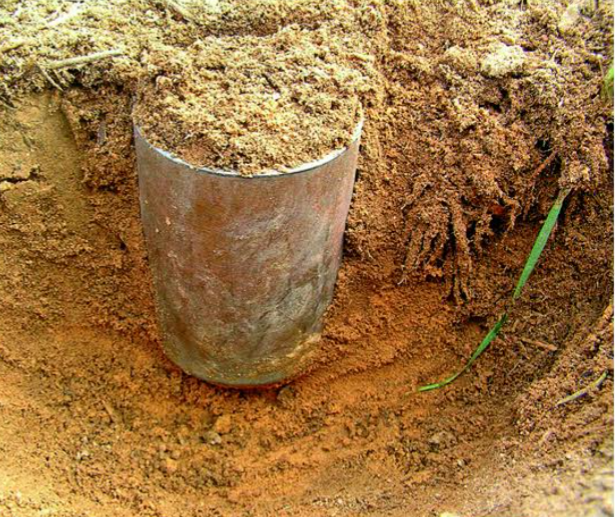
Bulk density also known as dry bulk density is the weight of soil in a given volume. Soils with a bulk density higher than 1.6 g/cm3 tend to restrict root growth. Bulk density increases with compaction and tends to increase with depth. This makes bulk density an indicator of soil compaction. Sandy soils are more prone to high bulk density than other soil types.
Bulk densities (BD) within the different layers of soil is a function of tillage system, the soil type and fertilizer management adopted. It provides information about the water storage capacity, structural conditions, and compactness of the soil.
High BD is the most troublesome feature of reconstructed soil on surface-mined land. The surface bulk densities of mine soils are usually greater than those of undisturbed soils because of their compacted state, lack of structure, and high coarse-fragment content.
CALCULATION OF BULK DENSITY
Two methods are used for bulk density determination. The method chosen depends on the site characteristics. The two commonly used methods are:
(1) the core method
(2) the excavation method.
CORE METHOD
The core method is used when coarse fragments (particles with diameter > 2 mm) occupy less than 25% of total soil volume. At sites with lots of coarse particles and/or tree roots, the core method is difficult to use and the excavation method is recommended.
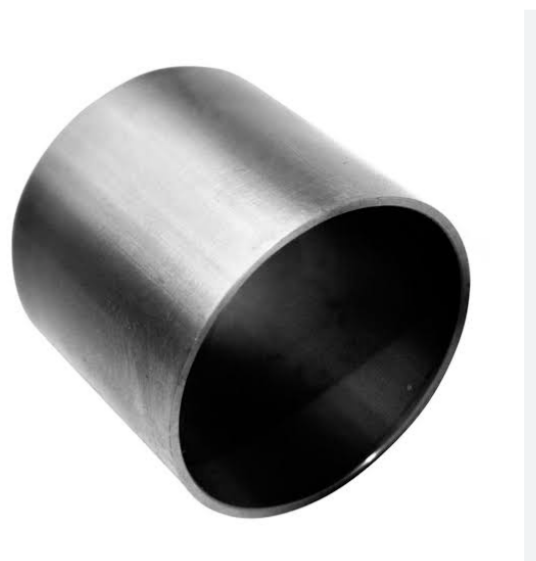
EXCAVATION METHOD
The excavation method was developed by soil engineers who needed a method suitable for use in gravelly soil. This method is used when coarse fragment content exceeds 25% by volume. At forested sites this is usually the preferred method for soil bulk density determination.
Bulk density measurements can be done if the soil is compacted or as part of fertiliser or irrigation management plans. And also when comparing management practices such as cultivated vs. non-cultivated soils. This is because physical soil properties are often altered.
The most common method of measuring soil BD is by collecting a known volume of soil using a metal ring pressed into the soil (intact core), and determining the weight before and after drying.
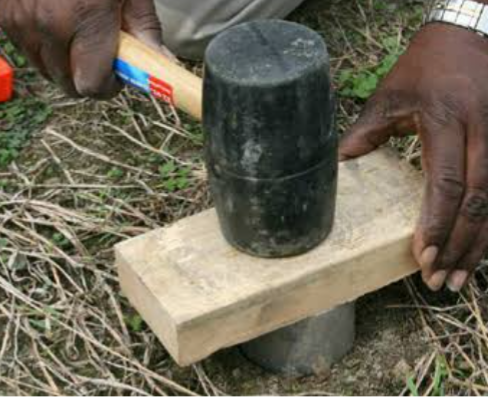
The soil bulk density (BD) is the weight of dry soil (Wsolids) divided by the total soil volume (Vsoil).
The total Soil volume = ring volume
Ring volume (cm3) = 3.14 x r2 x ring height.
Soil bulk density (BD)= Wsolids/ Vsoil
The total soil volume (Vsoil) is the combined volume of solids and pores which may contain air (Vair) or water (Vwater), or both.
(Vsoil)= volume of solids + pores
The average values of air, water and solid in soil are easily measured and are indication of a soils physical condition.
Bulk density is usually expressed in megagrams per cubic metre (Mg/m3) but the numerically equivalent units of g/cm3 and t/m3 are also used (1 Mg/m3 = 1 g/cm3 = 1 t/m3).
CRITICAL BULK DENSITY
Different soil types have different critical value of bulk density that restrict root growth. But in general, bulk densities greater than 1.6 g/cm3 tend to restrict root growth. Sandy soils usually have higher bulk densities ranging from 1.3–1.7 g/cm3, while fine silts and clays have lower bulk density range of 1.1 – 1.6 g/cm3 because they have larger, but fewer pore spaces. Clay soils are characterised with very small particles sizes with great amount and small pore spaces. This makes it have good soil structure. Soils rich in organic matter (e.g. peaty soils) can have bulk densities of less than 0.5 g/cm3.
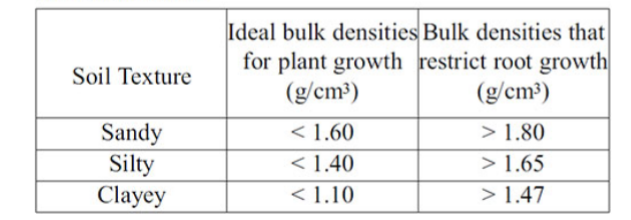
A BD of less than or equal to 1.3 g cm−3 is considered good, between 1.3 and 1.55 g cm−3 is fair, and greater than 1.8 g cm−3 is considered extremely bad. Bulk densities above thresholds indicate impaired function.
The optimal and critical limits of soil BD are dependent on soil texture, particle size, management practices, and organic matter content
IMPORTANCE OF BULK DENSITY
1. Soil BD and porosity (the number of pore spaces) reflects the size, shape and arrangement of particles and voids (soil structure).
2. Both BD and porosity (Vpores) give a good indication of the suitability for root growth
3. It gives a good indication of soil permeability
4. It is vitally important for the soil-plant-atmosphere system
5. Bulk density can be used to calculate soil properties per unit area (e.g. kg/ha).
6. Soil with a low BD (<1.5 g/cm3) allows optimum movement of air and water through the soil.
7. Bulk density can be used to calculate total mass of carbon within an area.
8. Bulk density reflects the soil’s ability to function for structural support, water and solute movement, and soil aeration.
9. Bulk density is also used to convert between weight and volume of soil.
10. It is used to express soil physical, chemical and biological measurements on a volumetric basis for soil quality assessment and comparisons between management systems.
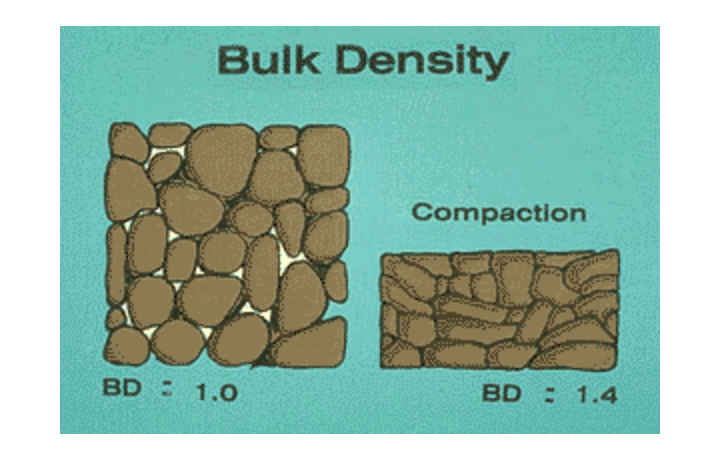
FACTORS THAT AFFECT BULK DENSITY
1. If soils are wetter than field capacity, bulk density may increase.
2. If soils are dry, bulk density is not affected much.
3. Natural root growth is restricted as BD becomes greater than 1.5 g cm−3 in fine-textured (clay and silt) soil and at 1.7 g cm−3 in course-textured soil (sandy)
4. Tillage operation can increase bulk density if it breaks down aggregates and allows soil separates to pack more tightly.
5. Adding organic material decreases bulk density because organic material has a lower bulk density.
6. Soil bulk density determines the infiltration, available water capacity, soil porosity, rooting depth/restrictions, soil microorganism activity, root proliferation, and nutrient availability.
7. An increasing bulk density implies a decrease of macropores and an increase in meso- and micropores and the resultant changes impacted on hydraulic conductivity.
8. Increasing bulk density not only induces changes in the pore-size distribution but also affects the ability of soil to shrink and to conduct water in the soil.
9. Soil bulk density can vary substantially among different soil types and is affected by management practices (e.g. tillage, livestock grazing, timber harvesting).
10. Incorporation of large amounts of organic matter into the soil will lower the bulk density, while processes that compact the soil will increase bulk density.
EFFECT OF POOR BULK DENSITY
High bulk density is an indicator of low soil porosity and soil compaction. It may restrict root growth, and poor movement of air and water through the soil. Compaction can result in poor plant rooting and growth, thus, affecting crop yield and reducing vegetative cover that needed to protect the soil from erosion. Compaction can also reduce water infiltration into the soil thereby causing an increase in runoff and erosion especially from sloping land or waterlogged soils in flatter areas. In general, some soil compaction restrict water movement through the soil profile. This is beneficial under arid conditions, but under humid conditions compaction decreases yields.
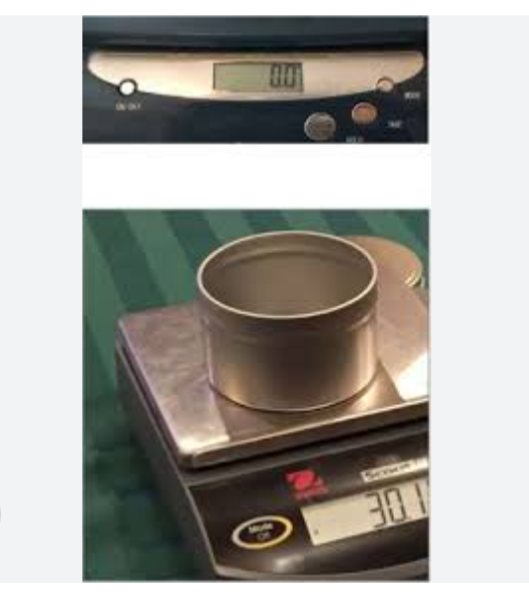
The following practices can lead to poor bulk density:
1. Consistent primary tillage operation at the same depth,
2. Tillage equipment traffic, especially on wet soil,
3. Reducing crop rotation and including crops with similar rooting structure at thesame rooting depth. For example, planting only shallow rooting crops.
3. Burning or removing crop residues,
4. Overgrazing forage plants, and allowing development of livestock loafing areas and trails.
5. Using heavy equipment for building site preparation or land smoothing and leveling.
REMEDY FOR POOR BULK DENSITY
Any practice that improves soil structure such as avoiding tilling and planting when the soil is wet, practice zero tillage, Maintain and increase soil organic matter, trips across the field with equipment, planting cover crops with tap roots to penetrate compacted layers, Considering controlled traffic to reduce percentage of soil with a footprint etc, decreases bulk density. However, in some cases these improvements may only be temporary. For example, tillage at the beginning of the growing season temporarily decreases bulk density and contribute to compacted soil layers, but subsequent trips across the field by farm equipment, rainfall events, animals, and other disturbance activities can recompact soil.
To proffer solutions to problems of bulk density and soil compaction, soil disturbance should be reduced and soil organic matter increased. Compost, cover crops, crop residues, manures, mulch and reduced or no tillage results in increased soil organic matter, less disturbance and reduced bulk density. In addition, practicing crop rotation and including crops that grow roots to different rooting depths can help break up compacted soil layers.
In summary, high bulk density and compaction can be reduced by:
1. Minimize soil disturbance and production activities when soils are wet,
2. Practicing controlled traffic farming or controlled equipment traffic,
3. Reduce the number of trips across the field
4. Use subsoiler to disrupt existing compacted layers
5. Use a ripper to loosen the soil surface.
6. Planting seeds in planting basins
7. Use practices that maintain or increase soil organic matter.
8. Sowing of a strong rooted cover crops
9. Application of manure, organic fertilisers and lime
10. Practicing grazing systems that minimize livestock traffic and loafing, and adhere to recommended minimum grazing heights reduce bulk density by preventing compaction.
11. Practicing conservation agriculture results in reduction of bulk density. Such conservation practices include: conservation crop rotation,
cover crop , deep tillage , prescribed grazing and
residue and tillage management.
